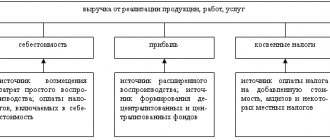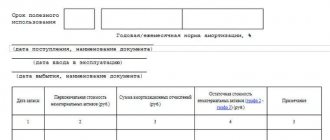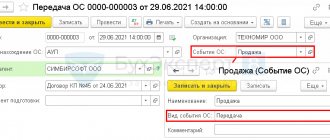Sales of goods, works, services: how to reflect them in accounting
Every commercial organization is created to make a profit.
To do this, the organization sells finished products, goods, provides services, performs work, and buyers and customers pay for the products. For an accountant in the sales area, it is important to control accounts receivable, carry out reconciliations with counterparties, track accrued VAT, and correctly formulate a sales book. Main accounts: 62, 90, 68 “Calculations for VAT”. Work on selling products in an organization begins with concluding an agreement with the buyer; the agreement can sometimes be an invoice for payment. Once the intent to purchase has been secured by contract, the buyer is usually issued an invoice. The invoice indicates the seller’s details, including bank details, the amount of payment, taxes (VAT, excise taxes) included in the cost of goods (work, services).
The invoice is issued by an authorized person, usually a manager or accountant, in 2 copies: one for the buyer, the second for the accounting department. Signed by the manager and chief accountant. Own copies are filed in chronological order, copies of the buyer are sent to him.
Sales of goods, works, services
Work on selling products in an organization begins with concluding an agreement with the buyer; the agreement can sometimes be an invoice for payment. Once the intent to purchase has been secured by contract, the buyer is usually issued an invoice. The invoice indicates the seller’s details, including bank details, the amount of payment, taxes (VAT, excise taxes) included in the cost of goods (work, services).
The invoice is issued by an authorized person, usually a manager or accountant, in 2 copies: one for the buyer, the second for the accounting department. Signed by the manager and chief accountant. Own copies are filed in chronological order, copies of the buyer are sent to him.
Settlements with buyers and customers are carried out on account 62 “Settlements with buyers and customers”. Revenue is reflected in subaccount 90.1 “Revenue”.
Implementation
Settlements with buyers and customers are carried out on account 62 “Settlements with buyers and customers”. Revenue is reflected in subaccount 90.1 “Revenue”.
Goods, finished products
To ship goods and products, a consignment note TORG-12 is issued in two copies and transferred to the warehouse to the warehouseman. The storekeeper releases goods based on a power of attorney.
If the organization has shipped products or goods and ownership has passed to the buyer, then the fact of sale is reflected in the accounting records with the following entry:
Debit 62 Credit 90.1 - revenue from the sale of products (goods) is reflected. Revenue is reflected together with VAT.
At the same time, it is necessary to reflect the write-off of the cost of goods (products) in the debit of subaccount 90-2 “Cost of sales”, income from the sale of which is recorded in subaccount 90.1.
Debit 90.2 Credit 41 (43,45,20...) - the cost of goods sold is written off.
The organization must charge VAT simultaneously with the sale. She must issue an invoice within five calendar days from the date of shipment of the goods.
Debit 90.3 Credit 68 “Calculations for VAT” - VAT has been charged.
Agreement with a special transfer of ownership
If the contract specifies that ownership of the goods will be transferred not after shipment, as is considered by default, but, for example, after payment, such an agreement is considered an agreement with a special transfer of ownership. Shipped goods must be accounted for on account 45 “Goods shipped”.
Debit 45 Credit 41 - goods (GP) were shipped under an agreement with a special transfer of ownership.
Even though title has not passed to the buyer, VAT must be charged on the day of shipment.
Debit 76 “Calculations for VAT on advances received” Credit 68 - VAT accrued on goods shipped.
Debit 51 Credit 62 - the buyer’s payment is reflected.
Debit 62 Credit 90.1 - revenue is reflected.
Debit 60.2 Credit 45 - the cost of shipped goods is written off.
Debit 90.3 Credit 68 - VAT charged
Debit 68 Credit 76 “Calculations for VAT on advances received” - VAT accrued on shipments has been restored.
Services, works
If an organization has provided services or performed work, then this fact is documented in an act in a free form; there is no standard form, for example, an act of provision of services or an act of completed work. You also need to issue an invoice.
Postings for the provision of services and performance of work are the same as for the sale of goods and finished products:
Debit 62 Credit 90.1 - revenue accrued for services rendered.
Debit 90.2 Credit 20, 26 - the cost of services provided and work performed is written off.
Debit 90.3 Credit 68 - VAT charged.
Buyer Payment
Buyer payment for goods. work and services are reflected in accounting based on:
- bank statement, if the money was received in the current (currency) account - Debit 51 (52) Credit 62.
- cash receipt order, if payment is in cash - Debit 50 Credit 62.
Advance from the buyer
If the organization works on an advance payment basis and before shipment, the buyer must pay an advance payment.
Debit 50, 51.52...Credit 62 subaccount “Calculations for advances received” - the buyer transferred the advance.
VAT must be charged on the advance received at a rate of 18%/118 or 10%/110.
Debit 76 “Calculations for VAT on advances received” Credit 68 - VAT was charged on the advance.
After the goods (work, services) have been transferred to the buyer and ownership has passed to him, the following entries are made in accounting:
Debit 62 Credit 90.1 - revenue is reflected.
Debit 62 subaccount “Settlements on advances received” Credit 62 - the buyer’s advance is credited.
Debit 90.2 Credit 41 (43,45,20...) - the cost of goods, works, services is written off.
Debit 90.3 Credit 68 - VAT charged.
Debit 68 Credit 76 “Calculations for VAT on advances received” - the VAT accrued on the advance received has been restored.
Business and Accounting
Sales of goods: postings
The main account for accounting for the sale of goods in accordance with the Chart of Accounts and Instructions for its application (Order of the Ministry of Finance dated October 31, 2000 No. 94n) is account 90 “Sales”. This account reflects the proceeds from the sale of goods, as well as expenses associated with the sale and VAT accrued on sales.
Let's present typical transactions for the sale of goods in the table:
| Operation | Account debit | Account credit |
| Revenue from the sale of goods is reflected | 62 “Settlements with buyers and customers” | 90, subaccount “Revenue” |
| Cost of goods sold written off | 90, subaccount “Cost of sales” | 41 "Products" |
| VAT is charged on the cost of goods sold | 90, subaccount “VAT” | 68 “Calculations for taxes and fees” |
| Expenses associated with the sale of goods are written off | 90, subaccount “Sales expenses” | 44 “Sales expenses” |
| Payment received from customers for goods sold | 51 “Currency accounts”, 52 “Currency accounts”, etc. | 62 |
The presented set of transactions assumes that revenue is recognized at the time of shipment of goods.
However, a situation is possible when, in accordance with the contract, ownership of the goods passes to the buyer, for example, at the time of payment. In this case, revenue is not recognized at the time of shipment, because one of the conditions for its recognition is not met - the transfer of ownership to the buyer (clause “d”, clause 12 of PBU 9/99). But since the goods actually leave the warehouse and are written off from accounting, at the time of shipment account 45 “Goods shipped” is used:
| Operation | Account debit | Account credit |
| Goods were shipped to the buyer under a contract with a special procedure for transfer of ownership (after payment) | 45 | 41 |
| VAT is charged at the time of shipment | 76 “Settlements with various debtors and creditors” | 68 |
| Payment received from buyers | 51, 52, etc. | 62 |
| Revenue from the sale of goods is recognized | 62 | 90, subaccount “Revenue” |
| The cost of previously shipped goods has been written off | 90, subaccount “Cost of sales” | 45 |
| VAT accrued at the time of shipment of goods is taken into account | 90, subaccount “VAT” | 76 |
| Expenses associated with the sale of goods are written off | 90, subaccount “Sales expenses” | 44 |
When they talk about reverse sales, they mean a set of accounting entries that the buyer must make in his accounting when returning the goods to the supplier. You can read about typical transactions when returning goods for various reasons in our material.
Accounting for sales of finished products
- home
- Postings
Let's consider the reflection of the sale of finished products as the most common operation. Sales of finished products are carried out under a supply agreement and are reflected similarly to transactions for the sale of goods.
The accounting entries of this business transaction reflect the situation when the transfer of ownership of finished products from the manufacturer to the buyer occurs at the time of shipment of the products.
Depending on the moment of calculation (payment) by the buyer for the products received, there are two options for generating accounting entries. The first version of the postings reflects the SALES of finished products, in which the moment of PAYMENT occurs AFTER the moment of SHIPMENT of the products. Moreover, the moment of payment for the products may occur significantly later than the moment of shipment, which will lead to the emergence of unpaid receivables from the manufacturer.
The second version of the postings reflects the SALES of finished products, in which the moment of PAYMENT occurs BEFORE the moment of SHIPMENT of the products. In this situation, the manufacturer has an account payable to the buyer, which he repays by shipping the products.
List of accounts involved in accounting entries:
|
|
| Account Dt | Kt account | Wiring Description | Transaction amount | A document base |
| 1. Sales of finished products with payment after shipment (transfer) | ||||
| 90.2 | 43 | The posting reflects the shipment of finished products. The amount of cost depends on the methodology for assessing the output of finished products | Cost of finished products | Consignment note (form No. TORG-12) |
| 62.01 | 90.1 | The posting reflects the revenue for the selling price of finished products including VAT. | Sales value of finished products (amount including VAT) | Consignment note (form No. TORG-12) Invoice |
| 90.3 | 68.2 | The posting reflects the amount of VAT on products sold. | VAT amount | Consignment note (form No. TORG-12) Invoice Sales book |
| 51 | 62.01 | The posting reflects the fact of repayment of debt for shipped products | Sales value of finished products | Bank statementPayment order |
| 2. Sales of finished products on prepayment | ||||
| 51 | 62.02 | The buyer's prepayment for finished products is reflected | Advance payment amount | Bank statementPayment order |
| 76.AB | 68.2 | VAT is charged on advance payment | VAT amount | Payment orderInvoiceSales book |
| 90.2 | 43 | The posting reflects the shipment of finished products. The amount of cost depends on the methodology for assessing the output of finished products | Product cost | Consignment note (form No. TORG-12) |
| 62.01 | 90.1 | Revenue is reflected in the selling price of finished products including VAT. | Sales value of finished products (amount including VAT) | Consignment note (form No. TORG-12) Invoice |
| 90.3 | 68.2 | VAT is charged on products sold | VAT amount | Consignment note (form No. TORG-12) Invoice |
| 62.02 | 62.01 | Previously received prepayment is counted towards repayment of debt for shipped products | Advance payment amount | Accounting certificate-calculation |
| 68.2 | 76.AB | VAT is credited from the prepaid payment | VAT amount | InvoicePurchase book |
Postings reflecting the disposal of finished products under commission agreements, barter, etc. similar to goods accounting
The concept of sales of goods, works or services
The sale of products and services is regulated by tax legislation, namely Article 39 of the Tax Code of the Russian Federation. Legal regulation of the sale of goods, works, and services is carried out by the Tax and Civil Codes of the Russian Federation.
The definition of the concept of implementation is presented in Chapter 39 of the Tax Code of the Russian Federation. The chapter determines that sales can only be carried out by organizations and individual entrepreneurs. It is carried out on a reimbursable basis through the transfer of funds or the exchange of goods and services.
In other words, the rights to the property are transferred to the buyer. It is also possible to transfer services free of charge from one person to another. This implementation method is often used when working with non-profits and social enterprises.
The Tax Code of the Russian Federation gives the following definition: the sale of products, work or services by entities (organization or individual entrepreneur) is a paid transfer of property rights in the form of goods or results of the provision of services from one person to another person. The conditions for implementation and its types are provided for by the Tax Code.
Transfer of property rights free of charge is also possible, but only in cases where the transfer is secured by agreement. Such relations are also regulated by the norms of the Tax Code of the Russian Federation and the Civil Code of the Russian Federation.
For tax purposes, for accounting purposes, cost and profit are determined and a statement is drawn up that contains entries for all sales transactions.
To correctly draw up a document, an accountant or company manager must reliably determine cost and profit and make entries. Based on the results of such operations, the final profit (before tax) is determined, which is the subject of income tax.
Cost is the sum of all sales costs - raw materials, wages and related costs for the sale of goods, works and services. The correct preparation of tax returns for income tax, VAT, etc. depends on the correct posting to cost.
Violations in tax calculations entail penalties in the form of fines and penalties.
Sales accountant: responsibilities
A specific list of functional responsibilities of an accountant for sales is not established at the legislative level. In this regard, companies are given the opportunity to independently determine the actual list of responsibilities depending on the specifics of the organization’s activities.
When developing a job description for a sales accountant, it is necessary to be guided by the provisions of the current labor legislation. In the process of carrying out work, the sales accountant reports to his immediate supervisor, namely the chief accountant or deputy chief accountant, if there is one.
What should a sales accountant know?
First of all, the provisions of Russian legislation that determine the accounting methodology in commercial organizations.
Due to the fact that the formation of transactions for the sale of goods, works, and services constitutes the tax base when calculating budget payments, the sales accountant must be savvy in matters of tax legislation.
Since the entire accounting and tax accounting system is based on the use of a chart of accounts for business accounting, the sales accountant is required to understand the meaning of the accounts and their possible correspondence.
Currently, business accounting is automated. Accordingly, the importance of accounting programs such as 1C, Kontur and others will be a priority.
As for the job responsibilities of a sales accountant, they include:
- Reflection on business accounts of transactions for the sale of goods, works and services;
- Preparation of relevant documents when carrying out the operations described above;
- Calculating the cost of goods, works and services, identifying sources of losses and costs;
- Working with account 62 “Settlements with buyers and customers”;
- Periodic (at least once a quarter) reconciliation of mutual settlements with the company’s counterparties, generation of reconciliation reports;
- Control over the status of receivables and payables. Timely elimination of emerging debts, carrying out analytical measures on the reasons for their occurrence;
- Formation of a sales book;
- Formation of a log of issued invoices;
- Monitoring the correctness of registration of primary accounting documents;
- Preparation of data on the sales area and provision of relevant information to the chief accountant / deputy chief accountant for reporting.
The specific list is established by the company independently, depending on the specifics of its activity. Often, the sales accountant’s responsibilities include working with the client bank. When determining functionality, management should build on the current regulatory framework and professional standards intended for accountants.
Similar articles
- Accountant operator responsibilities
- Accountant for the implementation of duties in 2018
- Accountant operator responsibilities in 2021
- Accountant auditor responsibilities
- Job responsibilities of an HOA accountant
Place and moment of actual sale of goods, works or services
The definition of the second part of the Tax Code of the Russian Federation establishes the place and moment of actual implementation for individual taxes. The basis of Article 147 of the Tax Code of the Russian Federation recognizes the territory of the Russian Federation as the place of sale of products if the following clause is present: the goods must be located on the territory of Russia or in territories under the jurisdiction of the country, and it must be in the process of shipment and transportation.
In other words, the procedure for transferring goods that are transported or shipped to the seller is already controlled by the legal requirements for the sales operation.
Some differences are implied in the implementation of works and services, since these procedures are intangible. The territory of Russia is recognized as a place of sale of services in the following cases:
- if the work is related to real estate in the country (installation, restoration, repair work);
- if the work is related to movable property (cars, trucks, ships and aircraft on the territory of the Russian Federation (assembly, installation, processing and maintenance);
- services provided on the territory of the Russian Federation in the field of art, education, sports and tourism;
- the recipient of works and services carries out work on the territory of Russia.
The buyer’s place of business is recognized as the basis of his actual location on the territory of the Russian Federation on the basis of state registration documents.
In Determination No. 414-O dated November 24, 2005, the Constitutional Court of the Russian Federation indicates that paragraph 1 of Article 39 of the Tax Code of the Russian Federation cannot be considered as a provision that limits or violates the rights of taxpayers. The article is not of an independent regulatory nature.
The moment of sale for tax purposes is the date of receipt of income, regardless of their actual receipt in the seller’s accounts.
What is recognized as the sale of goods, works or services
The following operations are recognized as sales of products, services and works for business tax purposes:
- transfer of ownership rights to goods on a reimbursable basis, including exchange;
- transfer of ownership rights to the results of work from one person to another;
- provision of services on a reimbursable basis;
- provision of services free of charge or transfer of ownership rights free of charge. At the same time, VAT is still calculated on such transactions (according to Article 146 of the Tax Code of the Russian Federation).
For example, a gift agreement, under which one of the parties transfers ownership or property rights to third parties free of charge. This operation is also recognized as a sale, which means an object of taxation arises (personal income tax and VAT).
For income tax (as opposed to VAT), sales income is recognized as proceeds from the sale of goods, proceeds from the sale of property rights and services. That is, in order to determine profit as an object of taxation, revenue is necessary, since transactions on a gratuitous basis are deprived of such an opportunity.
Accounting for implementation purposes is carried out according to regulatory documents unified by the state.
All operations have postings that determine the cost and profit on sales. At the same time, he draws up a statement indicating the amount of each specific transaction.
Identified violations of the legislation on accounting for sales transactions make it possible to determine the location of the violation in order to avoid tax penalties in the future.
Analysis of account 90: sale of finished products, goods in 2021
Account 90 “Sales” is intended to reflect transactions related to the sale of finished products, goods, and services. Accounting account 90 is complex and has a number of sub-accounts. How are transactions recorded when selling on account 90? How is account 90 closed at the end of the year? We will conduct a detailed analysis of account 90, analyze the implementation process using the example of the sale of finished products and goods, as well as accounting entries for account 90.
As mentioned above, account 90 in the accounting department has several subaccounts; below are the main subaccounts used to reflect sales.
Main subaccounts to account 90
1 – the loan reflects revenue from the sale of goods and products;
2 – the cost of what we sell is entered in debit;
3 – the debit reflects VAT accrued on sales;
9 – at the end of the month, results are summed up in this subaccount: the financial result from sales for the month is calculated, profit is recorded in debit, and loss is recorded in credit.
Let us remember that an accounting account is a two-sided table, the left side of which is called debit, and the right side is called credit. The count of 90 can be represented schematically as follows:
The main distinctive feature of this account is that it closes completely (to zero) only at the end of the year. Throughout the calendar year, a balance accumulates in each subaccount from month to month. At the end of the year, each sub-account is closed, and the total financial result for the year is calculated.
Video - What you need to know about counting 90:
Sales of goods on account 90
First, let’s look at how, in general, sales are reflected in account 90, and what transactions need to be made.
If the sale being made is a regular activity of the enterprise, then accounting account 90 is used to reflect it (if this is a one-time sale, for example, the sale of a fixed asset, then account 91 is taken here, which is analyzed in detail).
Sales income is revenue; it is reflected on the credit of subaccount 1 in correspondence with the account for settlements with customers. (The topic of invoice correspondence was discussed in this article). That is, when shipping goods or products to the buyer, posting D62 K90/1 is made, which reflects the proceeds from this sale.
Sales expenses are collected in the debit of account 90.
The debit of subaccount 2 reflects the cost of goods and products sold.
In the case of the sale of goods, expenses are the costs of purchasing goods and the costs incurred during direct sale. The entry for recording the costs of purchasing goods has the form D90/2 K41, the entry for writing off sales expenses is D90/2 K44.
When selling finished products, the cost of production is written off to the debit of subaccount 2 using posting D90/2 K43.
According to the Tax Code of the Russian Federation, if an organization is a VAT payer, then value added tax must be charged on the products sold, the VAT charge is reflected by posting D90/3 K68.VAT.
Accounting entries:
★ Best-selling book “Accounting from scratch” for dummies (understand how to do accounting in 72 hours) > 8,000 books purchased
You can get an answer to your question by calling the numbers ⇓ Free consultation Moscow, Moscow region call
One-click call
St. Petersburg, Leningrad region call: +7 (812) 317-60-16
One-click call
Closing 90 accounts at the end of the year
During the month, all sales are reflected in this way. At the end of the month, the balance is calculated for each subaccount and the financial result for the month is displayed. How does this happen?
1. The amounts for each subaccount are added up, that is, the turnover for credit is 90/1, for debit 90/2, for debit 90/3.
2. From the total debit turnover (subaccount 2 + subaccount 3), the credit turnover (subaccount 1) is subtracted.
3. If you receive a positive number, it means there is a loss for the month, that is, expenses exceeded income. The loss is reflected by posting D99 K90/9, where account 99 “Profits and losses” is used to generate the final financial result.
4. If we receive a negative number, it means that we have a profit for the month; we reflect it by posting D90/9 K99.
With the beginning of a new month, account 90 is re-opened, the balance of each sub-account is transferred to the corresponding sub-accounts of the new 90 account.
We continue to take into account all sales transactions throughout the month, and at the end of the month we again calculate the financial result for the month.
And this continues from month to month until the end of the year.
Closing account 90 at the end of the year (postings):
At the end of the year, account 90 must be closed so that the balance of each subaccount becomes zero. In this case, each subaccount is closed to subaccount 90/9:
- 90/1: we consider the final balance, it is a credit balance, in order for the balance on this subaccount to become zero, you need to post D90/1 K90/9.
- 90/2: we calculate the final balance, it is a debit, in order for the balance to become equal to zero, we carry out the posting D90/9 K90/2.
- 90/3: similar to subaccount 2, we carry out posting D90/9 K90/3.
- 90/9: now, if you calculate the final balance on this subaccount after completing all previous entries, it will be equal to 0.
Account 90 is closed.
At the beginning of the new year, we will re-open account 90 with a zero balance on all sub-accounts and begin recording sales transactions anew.
Reflection of the implementation process on accounting accounts
The process of selling (selling) products is reflected in account 90 “Sales”. This account reflects the organization's income and expenses for its primary and secondary activities. This account is active-passive, depending on the account corresponding to it.
| Dt (Debit) | 90 "Sales" | Kt (Credit) | |
| Opening balance | |||
|
| ||
Typical accounting entries:
On the debit of account 90:
- D90 K43 - finished products of the current year were sold at the planned cost;
- D90 K43 - last year’s finished products were sold at actual cost;
- D90 K68 — VAT included;
- D90 K44 - sales expenses written off;
- D90 K20 - adjustment for products sold is written off;
For account credit 90:
- D62 K90 - revenue accrued for products sold (VAT is calculated from this amount).
At the end of the year, the financial result from sales is determined by comparing debit and credit turnover.
The result from the sale of products as a whole is determined on account 90/9 “Profit (loss) from sales”
If the debit turnover is greater than the credit turnover, then the farm suffered a loss - D90/9 K 90/1.
If the credit turnover is greater than the debit turnover, then the farm has made a profit - D90/1 K90/9.
Profit (loss) for the farm as a whole is reflected in account 99.
If the amounts recorded in the debit of account 90/9 are greater than the turnover on the loan, then the result of sales is a loss D99 K90/9.
If the amounts recorded on the credit of account 90/9 are greater than the turnover on the debit, then the result of sales is profit - D90/9 K99.






